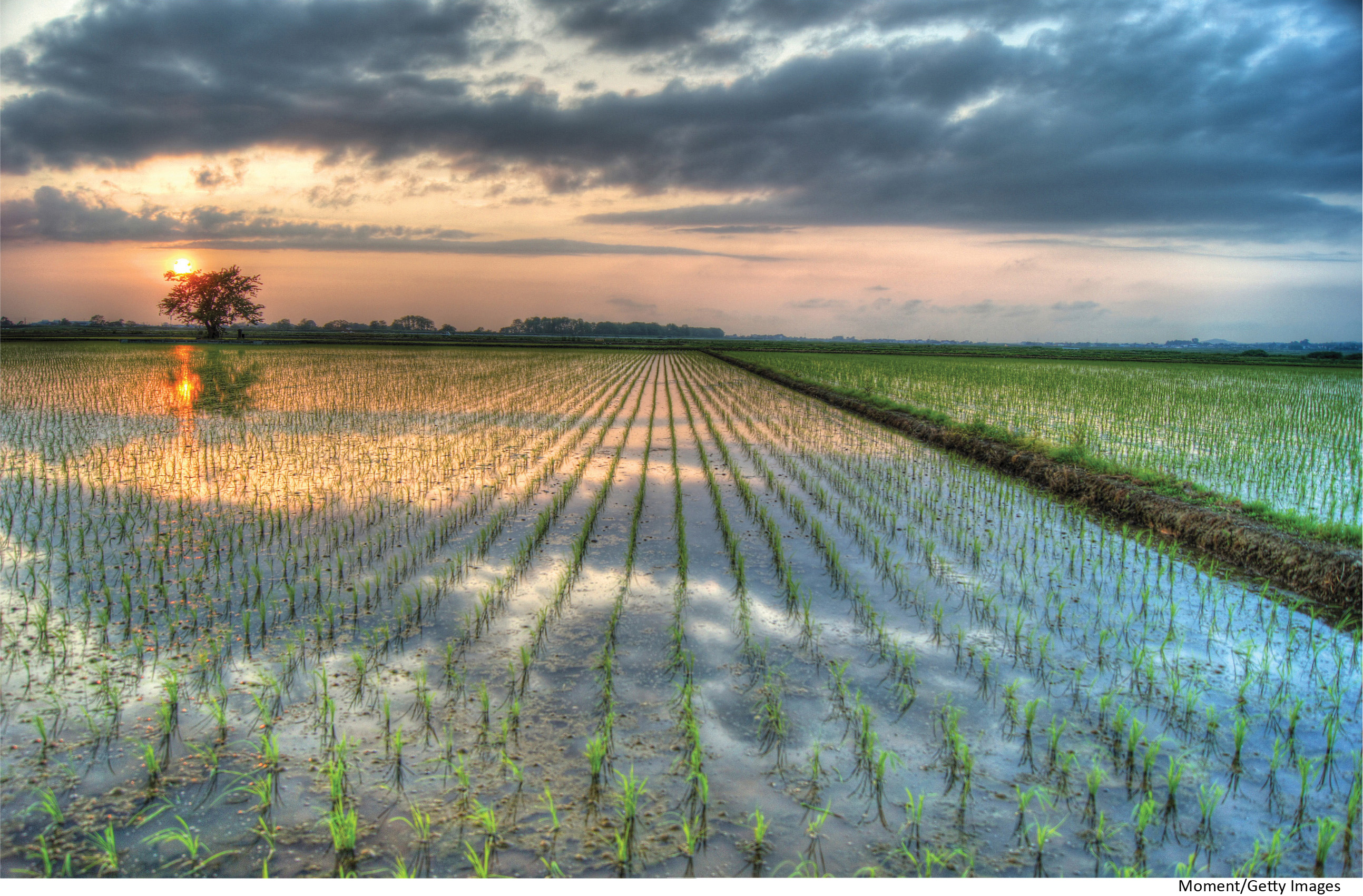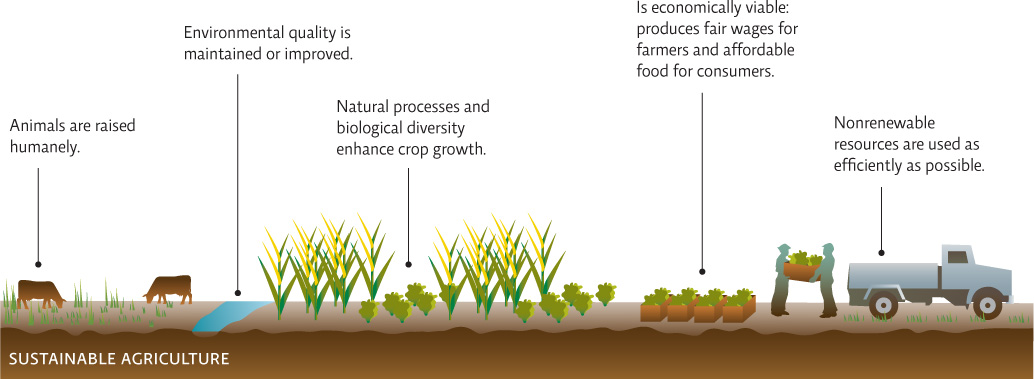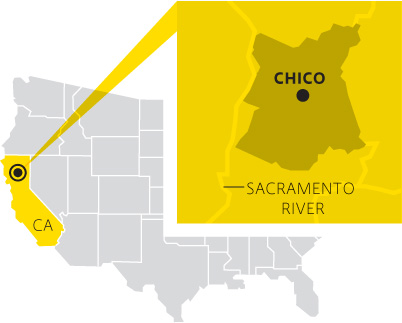Chapter Introduction
316
CHAPTER 17
SUSTAINABLE AGRICULTURE: RAISING CROPS
FARMING LIKE AN ECOSYSTEM
Creative solutions to feeding the world

CORE MESSAGE
Achieving food security for all people requires that we build a sustainable food system. Sustainable agriculture methods can help us grow crops within the means of the local ecosystem and without degrading the soil, water, and biodiversity that support that growth. Changes in consumer purchasing practices to support more sustainably produced food will give these foods the economic backing their producers need to succeed, while providing consumers with healthier food.
AFTER READING THIS CHAPTER, YOU SHOULD BE ABLE TO ANSWER THE FOLLOWING GUIDING QUESTIONS
1 What is sustainable agriculture, and how does it differ from industrial agriculture?
2 What environmental problems result from the use of industrial agriculture methods such as the application of synthetic fertilizers and pesticides?
317
3 What are some examples of methods employed by those pursing sustainable agriculture, and how do these methods decrease the impact of farming?
4 What role does the consumer play in helping build a sustainable food system?
5 What are the advantages and disadvantages of sustainable farming? Can it feed the world?
318
If there’s one thing Greg Massa and his wife Raquel Krach hate, it’s weeds—all varieties, but especially the azolla—an insidious, fernlike plant that grows on the surface of water. Each spring, azolla plants invade the couple’s rice farm, snaking their way through the dense, muddy paddies that stretch for miles along the Sacramento River near Chico, California. They strangle young rice plants and force Greg into an endless and tedious battle.
The rivalry—Massa versus azolla—has spanned three generations. Greg’s great-grandfather, Manuel Fonesca, planted the family’s (and some of California’s) first rice crops in 1916, on the same land that Greg and Raquel now manage. Back then, rice farming was a hard and uncertain life; Manuel was largely powerless against the azolla, which in some seasons claimed his entire crop.
By 1962, when Greg’s father, Manuel, took over, human ingenuity and modern science had completely changed the nature of the fight. Heavy doses of chemical herbicides enabled him to obliterate the weed. And specially bred higher-yield rice varieties developed during the Green Revolution (see Chapter 16), along with modern farming equipment and a heavy dose of chemical fertilizers and pesticides, made the family farm both efficient and profitable. Of course, that modern approach, known as industrial agriculture, has its own problems. It relies on cheap fossil fuel energy and huge amounts of water. It also leads to a progressive degradation of the environment.
fertilizer
A natural or synthetic mixture that contains nutrients that is added to soil to boost plant growth.
pesticide
A natural or synthetic chemical that kills or repels plant or animal pests.
industrial agriculture
Farming methods that rely on technology, synthetic chemical inputs, and economies of scale to increase productivity and profits.
Greg and Raquel wanted to find a better, more sustainable way. Sustainable agriculture is farming that meets the needs of the farmer and society as a whole without compromising the environment or future productivity. The techniques used will maintain or even enhance the environment. They often do this by mimicking the traits of a sustainable ecosystem: They rely on renewable energy and local resources for inputs, and they depend on biodiversity to trap energy, deal with waste, and control pest populations. INFOGRAPHIC 17.1
sustainable agriculture
Farming methods that can be used indefinitely because they do not deplete resources, such as soil and water, faster than they are replaced.
SUSTAINABLE AGRICULTURE
According to the U.S. Department of Agriculture, sustainable agriculture is farming that uses only limited amounts of nonrenewable resources (like fossil fuels) and does not degrade the environment or the well-being of people or society as a whole.


Organic farming is a subset of sustainable farming. What do these farming methods have in common, and how do they differ?
Both methods have as an underlying goal to farm without damaging the environment. Organic farming is more restrictive in that it prohibits the use of synthetic fertilizers and pesticides, and GMOs.
So when Greg and Raquel took over in 1997, they converted a portion of their farm to a sustainable farming method known as organic agriculture. Instead of using synthetic fertilizers and pesticides, organic agriculture employs more natural, or “organic,” techniques in the growing of crops—such as using manure as fertilizer and luring in natural predators to control pests. In addition, genetically modified organisms (GMOs) cannot be grown on organic farms (see Chapter 16). This type of farming uses fewer or no chemicals and in some cases may even produce food that is more nutritious. A 2014 meta-analysis of 343 studies showed that organic food had levels of antioxidants as much as 50% higher than that in conventionally grown crops. For example, research by Washington State University soil scientist John Reganold showed that organically grown strawberries had a longer shelf life and a higher level of antioxidants than conventionally grown berries. The meta-analysis also showed that, on average, conventionally grown food had four times more pesticide residue than organic food. But organic farming forced Greg and Raquel to battle weeds much as the first Manuel had: with great difficulty.
organic agriculture
Farming that does not use synthetic fertilizer, pesticides, GMOs, or other chemical additives like hormones (for animal rearing).
KEY CONCEPT 17.1
The goal of sustainable agriculture is to raise food without damaging the environment or future productivity while operating ethically with regard to animals and local communities.

319
KEY CONCEPT 17.2
Industrial agriculture is very productive but relies on large amounts of fossil fuels and water, degrades the soil and local environment (reducing future productivity), and is criticized for treating animals unethically.
The trick was to lower water levels enough to kill water-loving weeds but not so much that the rice crop also died. Each day, Greg would wade into the paddies to see how the rice plants were faring against the azolla. Some weeks, he worried the entire crop would die. After a few seasons, the Massas started to despair: How could they make their farm environmentally friendly without losing their livelihood to an army of mangy weeds?
The Massas’ story is the story of modern farming; it’s the story of how we feed ourselves. And on a planet where population is exploding, climate is shifting, and energy and water resources are running low, it’s also a story of constant change.